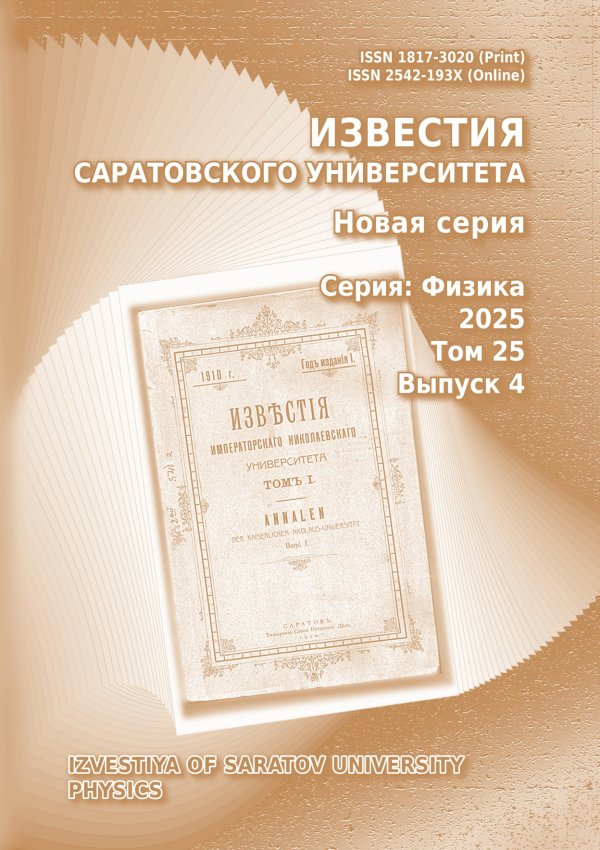Izvestiya of Saratov University. Physics
ISSN (print): 1817-3020, ISSN (online): 2542-193X
Founder: Saratov State University
Editor-in-Chief: Koronovsky Alexey Alexandrovich, Doctor of Physics and Mathematics. sciences, professor
Frequency / Access: 4 issues per year / Open
Included in: White List (4th level), Higher Attestation Commission List, RISC, Scopus
Registration PI № FS77-76653 of 26 August, 2019.
The electronic version of the journal is open access.
The journal subscription index is 36015. The subscription is available in online catalogue Ural-Press Group of Companies (ural-press.ru). The price is not fixed.
All journal articles are published under a licence Creative Commons Attribution 4.0 International (CC BY 4.0)
History of the journal
The journal "Izvestiya of Saratov University. New series" (ISSN 1814-733Х) was published since 2001. Its predecessors were the journals "Izvestiya of Saratov University" (1910-1918) and "Scientific notes of Saratov State University" (1923-1962). In 2005 the journal "Izvestiya of Saratov University. New series" launched a separate series "Izvestia of Saratov University. New series. Series: Physics", in 2021 the title changed for "Izvestia of Saratov University. Physics" (ISSN 1817-3020 print, ISSN 2542-193X online).
The journal is intended for readers involved in the field of physics and engineering education, physical science research workers, University professors, undergraduate and graduate students and organizers of production.
The purpose and objectives of the journal
The purpose of the journal is to reflect modern ideas about the physical picture of the world, contributing to the development of educational and research activities in the field of physics and its applications.
The objectives of the journal are:
- publication of original scientific papers in various areas of physical science and its applications (including nanotechnology and other critical technologies) in accordance with the content of passports of specialties of scientists in theoretical physics, radiophysics, physical electronics, solid state electronics, optics, laser physics, biophysics;
- publication of scientific and methodological materials that contribute to the improvement of the educational process in the physical and engineering-physical areas of training;
- publication of scientific reviews on priority areas of science and high technologies;
- publication of historical information about Saratov University, its mission in the field of physical education and physical science.
Articles should be prepared according to the rules of the journal.
The languages of publications are Russian and English.
Publications are free of charge.
Ағымдағы шығарылым
Том 25, № 4 (2025)
- Жылы: 2025
- Мақалалар: 13
- URL: https://journals.rcsi.science/1817-3020/issue/view/24313
Бүкіл шығарылым
Theoretical and Mathematical Physics
On the properties of stationary configurations of a rotating self-gravitating ideal fluid with a vortex gravitational field
Аннотация
 396-407
396-407


Radiophysics, Electronics, Acoustics
On peculiarities of application of the auxiliary system approach for the generalized chaotic synchronization regime detection
Аннотация
 408-413
408-413


Development of a prototype of flexible antennas with a passivation layer for electrical impedance sensors
Аннотация
 414-424
414-424


Optics and Spectroscopy. Laser Physics
Hydrogen bonding in saturated acids triglyceride monohydrates: MD and DFT modeling
Аннотация
 425-437
425-437


Design of a terahertz radiation modulator based on the effect of multi-wave interfence in a layered structure consisting of a large number of liquid crystal π-cells
Аннотация
 438-448
438-448


Biophysics and Medical Physics
Comparison of coarse-grained and all-atom “membrane-solvent” systems as models of memcapacitors under alternating electric field
Аннотация
 449-459
449-459


Thermal imaging of microhemodynamics and integrated mapping of sweat gland activity as a method for diagnosing autonomic neuropathy
Аннотация
 460-473
460-473


Estimation of the stationarity time of infra-slow oscillations of brain potentials using electroencephalogram signals
Аннотация
 474-484
474-484


Nanotechnologies, Nanomaterials and Metamaterials
Sensor properties of thin films of perforated graphene functionalized with COOH groups: DFTB study
Аннотация
 485-494
485-494


Investigation of the conductive properties of composite polymer materials based on polyvinylpyrrolidone doped with single and double-walled nanotubes
Аннотация
 495-504
495-504


From the History of Physics
Academician Lev P. Pitaevskii: Saratov years of life, family aura
Аннотация
 505-518
505-518


Personalia
 519-521
519-521


 522-523
522-523












